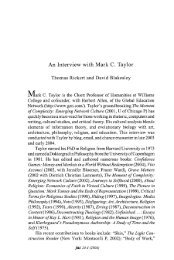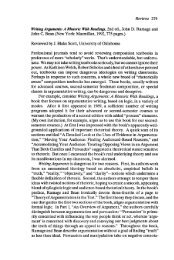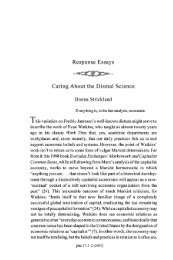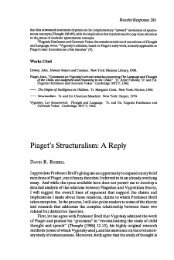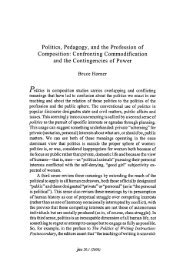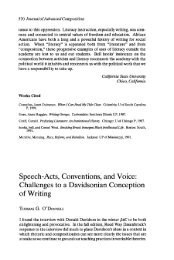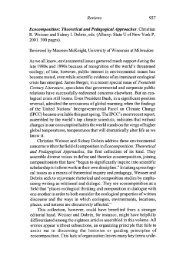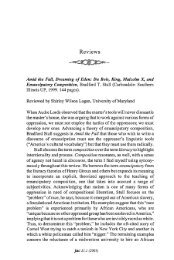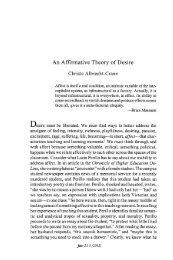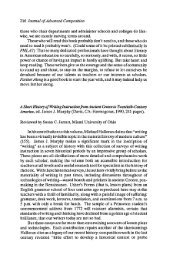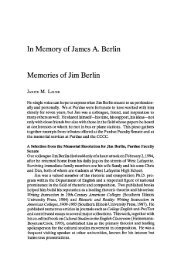Susan C. Jarratt, “Beside Ourselves: Rhetoric and ... - JAC Online
Susan C. Jarratt, “Beside Ourselves: Rhetoric and ... - JAC Online
Susan C. Jarratt, “Beside Ourselves: Rhetoric and ... - JAC Online
You also want an ePaper? Increase the reach of your titles
YUMPU automatically turns print PDFs into web optimized ePapers that Google loves.
Beside <strong>Ourselves</strong>:<br />
<strong>Rhetoric</strong> <strong>and</strong> Representation<br />
in Postcolonial Feminist Writing<br />
SUSANC.JARRATI<br />
The value of postcolonial theory for teachers of writing arises in part from its focus<br />
on the rhetorical situation of intellectual work applied to the question of difference.<br />
By pointing out that academic traditions of Western universities are built on several<br />
centuries of economic <strong>and</strong> cultural imperialism, this theory dem<strong>and</strong>s that scholars <strong>and</strong><br />
teachers of literature <strong>and</strong>literacies ask rhetorical questions the answers to which had<br />
been for many years assumed: who speaks? onbehalfofwhom? who is listening? <strong>and</strong><br />
how? It interrogates the assumption of any group identification <strong>and</strong> more specifically<br />
the relationship of the single "I" to acollective "we" (see Anderson, Mohanty, Roof<br />
<strong>and</strong> Wiegman!).<br />
My aim in this essay is to address the problem of speaking for others by looking<br />
athow"others"speak. Employing the figures of metaphor <strong>and</strong> metonymy, I analyze<br />
the ways three postcolonial feminists open up theworkings of representation-ofthe<br />
self, groups, <strong>and</strong> audiences-such that participants are no longer disposed in the<br />
classical rhetorical position, a single subject facing an audience, but rather, "beside<br />
themselves." This colloquial expression calls to mind situations of deep emotional<br />
turmoil-worry, anger, or maybe grief. Perhaps it means that, in times of intense<br />
emotional distress, one loses bodily or mental integrity <strong>and</strong> manufactures another<br />
version of oneself to express or absorb the pain. My appropriation ofthe expression<br />
bears some relation to its everyday use, in the sense that oppressed groups experience<br />
the pain of self-distancing or alienation (panon). As a rhetorician, though, I am<br />
interested in the wayan experience of suffering is turned into a tool oflanguage: an<br />
artful, rhetorical practice of self-multiplication used by speakers in response to their<br />
historical, rhetorical, <strong>and</strong> institutional circumstances. I am also interested in the way<br />
a painful image of self-division could be transformed into a hopeful vision of alliance.<br />
Tracing representational strategies of postcolonial feminist rhetoric might offer ways<br />
for composition teachers <strong>and</strong> students to imagine that scene-a difficult task in a<br />
culture that values individualism so highly. I hope this essay will contribute to that<br />
project in three ways: by analyzing changes in concepts of ethos <strong>and</strong> audience under<br />
the historical conditions of postcoloniality; by describing complex processes of<br />
writingtheself; <strong>and</strong>, by attending to theways teachers <strong>and</strong> students in U.S. universities<br />
"read" (about) formerly colonized people.
58<strong>JAC</strong><br />
Figuring structures of relation<br />
How can differences be imagined? In what forms of relation? <strong>Rhetoric</strong> is useful for<br />
addressing these questions because it gives names to figures which structure relations<br />
in language <strong>and</strong> in the material world. Any choice of a figure is a discursive act that<br />
also simultaneously configures a material relationship of power <strong>and</strong> difference. One<br />
oftheways postcolonial theory has heightened attention to the politics of representation<br />
is to point out that exercises of domination occur not only in the sphere of<br />
politics proper but also through cultural practices. They insist on the dual functions<br />
of rhetoric as both political <strong>and</strong> figurative representation.2 Gayatri Chakravorty<br />
Spivak, in her now-canonical essay "Can the Subaltern Speak?", warns first-world<br />
intellectuals about the danger of obscuring their own acts of discursive imperialism<br />
in the process of facilely "representing" the interests of apparently silent subjects of<br />
oppression. She makes her point historically <strong>and</strong> philologically, using Marx's essay<br />
on the mid-nineteenth-century coup d'etat of Louis Bonaparte, who came to<br />
"represent" a peasant class politically through an exercise of executive powerwithout<br />
their having any consciousness of themselves as aclass, i.e. without participating in<br />
an imaginative orpolitical constructionofthemselves as a class (Marx 602, 608). The<br />
typical translation oftwo different German words (Vertretung<strong>and</strong>Darstellunm into a<br />
single English word, "representation," emblemizes for Spivak the danger of collapsingthese<br />
two distinct processes: the first, a political or legal process of st<strong>and</strong>ing for<br />
members of a constituency group; the second a symbolic process of creating images<br />
of such groups ("Subaltern" 276; see also L<strong>and</strong>ry <strong>and</strong> MacLean 198). She associates<br />
these two forms of representation with two kinds of rhetoric, persuasion <strong>and</strong> trope,<br />
graphically captured in the analogies of "proxy" <strong>and</strong> "portrait" -arguing that in her<br />
historical example of Louis Bonapartethe former assumes or enacts the latter: "The<br />
event of representation as [a political process] ... behaves like an [imaging], taking<br />
its place in the gap between the formation of a (descriptive) class <strong>and</strong> the nonformation<br />
of a (transformative) class" ("Subaltern" 277). In other words, when someone uses<br />
power over others to represent them politically-to act for them-there is an<br />
unavoidable, concomitant symbolic process underway: the represented group is<br />
sketched, painted, described in a particular way through that process. And this<br />
description may or may not "represent" them in ways they themselves would endorse.<br />
The reason Spivak writes "nonformation" is to emphasize that "identity" as a<br />
class does not take place naturally (at what she calls "ground level consciousness "),<br />
but rather must be constructed through acts of political agency <strong>and</strong>self-description<br />
("Subaltern" 277-78). One cannot assume a class identity for the French peasants<br />
Louis Bonaparte forcibly represented in the absence oftheir own representations of<br />
themselves or of acts on their on behalf as a class. The backlash against feminism in<br />
the U.S. (<strong>and</strong> other countries as well) offers acontemporary example of processes of<br />
"nonformation" <strong>and</strong> transformation. Many women on university campuses reject<br />
feminism-i.e., reject being identified as a politicized class, "women" -because they<br />
believe they haven t had a h<strong>and</strong> in constructing the symbolic representations of the<br />
class. In Women'sStudiesclasses,femalestudentsactuallyread<strong>and</strong>discusstheworks<br />
of feminists (as opposed to absorbing uncritically the grotesque caricatures offered
<strong>Rhetoric</strong> <strong>and</strong> Representation 59<br />
on talk radio <strong>and</strong> other popular media). As they talk <strong>and</strong> write about the ways their<br />
self-identification fits with or differs from the representations they read, a process of<br />
class-formation/transformation takes place, creatingalocally grounded underst<strong>and</strong>ingofthe<br />
class "women" from which some will actually go forward to act out of that<br />
class consciousness (in campus activism, volunteer work, or career choices). Inevitably,<br />
their subsequent actions as "women" on behalfofother"women"will recreate<br />
the gap between political agency <strong>and</strong> self-description. 3<br />
Discoveringthe workings of these two forms of representation at any site, the<br />
interwoven operations of imaging-textual descriptions of otherness-<strong>and</strong> political<br />
representation-entailingidentification of or with a group-is the work of teachers<br />
<strong>and</strong> students of language practices. <strong>Rhetoric</strong> mobilizes an interaction between<br />
representation (political) <strong>and</strong>re-presentation (cultural), possibly enabling the transformative<br />
practices Marx found missing in the nineteenth-century French peasants:<br />
i.e., driving the movement from descriptivetotransformative class, or at leas tcalling<br />
attention to where <strong>and</strong> by whom groups are described. It is my argument that some<br />
postcolonial feminists have been particularly useful in activating rhetoric in these two<br />
senses, <strong>and</strong> that an analysis of their work in these terms might advance the argument<br />
over identity politics, helping to delineate with more care <strong>and</strong> refinement the bases<br />
on which identities areconstructed,claimed, <strong>and</strong>linkedwithothers. Thisframework<br />
might serve the ethical aim of "recognizing the responsibility for linking" (Faigley237).<br />
My method in the body ofthe essay isto use rhetorical figures-metaphor <strong>and</strong><br />
metonymy-to analyze the ways postcolonial feminist writing calls attention to these<br />
dual processes of representation: political <strong>and</strong> pictorial. In this analysis, I take<br />
metaphor as afigureof substitution: one thing or person st<strong>and</strong>ing in for another, <strong>and</strong><br />
in the process, obscuring some particularities of what it represents. 4 A metaphoric<br />
style of representation occurs anytime aspeakerorwriterfunctions as aspokesperson<br />
fora particular category of people-workers, women, voters in a particularconstituency-the<br />
partiality of the single member st<strong>and</strong>ing in for the whole. Here is an<br />
example of a critic using this definition of metaphor to distinguish autobiography<br />
fromtestimonio:<br />
In rhetorical terms, whose political consequences may be evident, there is a fundamental<br />
difference here betWeen themetaphorof autobiography <strong>and</strong> heroic narrative in general, which<br />
assumes an identity-by-substituting one (superior) signifierfor another (I for we, leaderfor<br />
follower, Christ forthe faithfuQ, <strong>and</strong> metonymy, a lateral move of identification-throughrelationship,<br />
which acknowledges the possible differences among ·us" as components of a<br />
centerless whole. (Sommer 61)<br />
Metonymy, on the other h<strong>and</strong>, as the passage above suggests, creates a chain of<br />
associations. It configures arelationship based on contiguity <strong>and</strong> context akobson<br />
79,83,90-91; Irigaray;Brady). The example of metonymy providedbyJakobson has<br />
an eerie resonance for postcolonial history. A hut may metonymically be associated<br />
with "thatched roof," "family of twelve, "or "burnt by the army," each association<br />
creatinganarrativeorcontextualizedunderst<strong>and</strong>ingofthewordwithoutdisplacing<br />
orblockingouttheworditself. Applyingmetonymytoidentitypoliticssuggeststhat
60<strong>JAC</strong><br />
differences can be spoken of not in terms of exclusive categories but rather as places,<br />
descriptions, or narratives of relation. The writings of Gayatri Spivak <strong>and</strong> Trinh T.<br />
Minh-haoffereloquent illustrations of what I see as a metonymic process of subject<br />
construction; each simultaneously makes visible the intellectual work of theorizing<br />
<strong>and</strong> gives voice to varieties of otherness, placing themselves not at the head of some<br />
silent group of followers but rather beside themselves. But in so doing, they<br />
unavoidably participate in a metaphoric process of representing "others," thus<br />
enactingatension between these two modes. Afteranalyzingrhetorics oflinkage<strong>and</strong><br />
spatial location in texts of the Spivak <strong>and</strong> Trinh, I will tum to a very different text.<br />
The 1983 testimonioofRigobertaMenchu Tum,sa Quiche Indian peasant <strong>and</strong> peace<br />
activist, arose from the midst of the Guatemalan civil war, a situation calling forth<br />
different strategies of representation from those used by postcolonial feminist<br />
academics writing within the context of the u.s. academy.6<br />
Immigrant academics as metonymic subjects<br />
My first two subjects are both are professional "representers," engaged in literary<br />
criticism <strong>and</strong> cultural critique (Spivak); in documentary filmmaking, ethnography,<br />
<strong>and</strong> cultural theory (Trinh). These feminist theorists are hypersensitive to the<br />
constructed nature of the discourse of personal experience yet, nonetheless, acknowledge<br />
the need for the representation of others-to give others a vocal <strong>and</strong> visible<br />
presence. They both meet this need through the production of what Spivak terms<br />
"counter-sentences" by subjects of imperialism: alternatives to re-presentationsimages<br />
of the "other" -produced from within dominant cultures. Such countersentences<br />
come into being through the strategic placement <strong>and</strong> voicing of narrative,<br />
but both Trinh <strong>and</strong> Spivak seek to avoidspeakingfortheotherthrough displacement<br />
<strong>and</strong> indirection. U nlikethe "ThirdWorldintellectuals" in metropolitan universities<br />
described by Ahmad, who "materially represent the undifferentiated colonized<br />
Other ... without much examining of their own presence in that institution" (92),<br />
Trinh <strong>and</strong> Spivak figure themselves with an awareness of their placement within<br />
systems of privilege <strong>and</strong>draw attention to the modes of production <strong>and</strong> consumption<br />
of their academic work.<br />
I tum first to cultural critic, Gayatri Spivak, an upper-casteIndian, an economic<br />
immigrant from Calcutta, who has studied <strong>and</strong> taught in English departments in U.S.<br />
universities since the early sixties. This biographical sentence introduces Spivak to<br />
those who don't know of her work but, by consolidating her into aunified,coherent<br />
subject, works against the grain of her own rhetoric. In the second half of the<br />
"Subaltern" essay, Spivak calls into question the desire of first world in tellectualsfor<br />
an authentic native voice when that desire is directed toward people like her.7 Spivak<br />
is at pains to point out her difference from that Other. She complicates the illusion<br />
ofasingle "native voice" by delineating various positions among Indians under British<br />
occupation. Setting off a silent underclass from those in closer contact with their<br />
colonizers, Spivak uses as her prime example acolonialsubject whose agency <strong>and</strong> voice<br />
had the least possibility of being heard-Indian widows who became victims of sati,<br />
sacrificial burning-to demonstrate how many of the historically colonized had in fact
<strong>Rhetoric</strong> <strong>and</strong> Representation 61<br />
no legitimate platform from which to speak ("Subaltern" 297-308; see also Mani).<br />
Spivak argues that this situation is aproblem not only for flrst-world intelle ctualsbut<br />
fordiasporic post-colonial academics as well in their own production of know ledge<br />
about their homel<strong>and</strong>s. Herconclusion is that apostcolonial intellectual cannot speak<br />
for these unrepresented groups but only to them in an imagined conversation across<br />
class lines <strong>and</strong> historical distances ("Subaltern" 295). The emphasis here is on<br />
"imagined," for of course Spivak assumes no possibility of reaching the present-day<br />
remnants of this group through the rarefied discourses of Western academies. 8<br />
Rather, she uses this formulation to displace the representative potent ialofherown<br />
voice,openingaspaceforothers. "Speaking to" might be construed as a movement<br />
fromthemetaphorictothemetonymic. Insteadofsubstitutingonevoiceforanother,<br />
the speaker adds another voice to the parallel str<strong>and</strong>s of discourse, a voice without<br />
its own clear origin. Her writings st<strong>and</strong> alongside other accounts <strong>and</strong> the person<br />
herself who continues to re-generate a speaking subject.<br />
The ethical implications of Spivak's performance lie in its difference from, on the<br />
one h<strong>and</strong>, a rhetoric of substitution, <strong>and</strong> on the other, from what Mohanty calls a<br />
"Westem, postmodemist notion of agency <strong>and</strong> consciousness which often announces<br />
the splintering of the subject, <strong>and</strong> privileges multiplicity in the abstract" (37). Spivak's<br />
performance should be understood as an ethical practice of seeking to displace any<br />
flxedsenseofknowledgeofthe"other"aWestemlistenermightbetemptedtograsp<br />
through an encounter with an elite, immigrant academic. When "card-carrying<br />
hegemonic"listenerslistenforsomeonespeakingasanIndian,aThirdWorldwoman<br />
speaking as a Third World woman, Spivak asserts, ignorance of acomplex history is<br />
coveredoverwith afabricatedhomogeneity (" Alterity"270). Within her chosen area<br />
ofliterary <strong>and</strong> cultural studies,9 Spivak puts before a Western audience a multitude<br />
of postcolonial subjects-the Indian widow of 1829, the sixteen-year-old member of<br />
an Indian independence group who committed suicide in Calcuttain 1926, the women<br />
workers in today's Export Processing Zones-along with her own "selves."<br />
Indeed, it seems that part of Spivak' s strategy for multiplying others is achieved<br />
through the manufacture of more <strong>and</strong> more versions of herself. She has experienced<br />
anamazingdegreeofpublicscrutiny,<strong>and</strong>I'minterestedinexamininghowshehas<br />
negotiatedherself-constitution through that process. 1hePost·Colonial Critic, aseries<br />
of interviews, collects <strong>and</strong> multiplies the many versions of this "highly commodi fied<br />
academic, " as she ironically calls herself ("Word" 130). In an interview with Ellen<br />
Rooney, she acknowledges complaints that "Spivak talks too much about herself"<br />
("Word" 130). Though this focus on the self might suggest the seduction of<br />
"representativeness," it might also be read as a continuing attempt to disperse the<br />
representative Indian in the U.S. academy.<br />
Spivak is meticulous about her own processes of self-identification. Refusing<br />
several of the available options for self-representation-unmediated accounts of<br />
experience, the philosophical voice from nowhere, <strong>and</strong> the hollow echoes of the nowdead<br />
"author" -Spivak instead practices "deidentification ... aclaimingofan identity<br />
from a text that comes from somewhere else. "10 Resisting the Western academy's<br />
attempt to hear from her the voice of the native, she differentiates "talking about
62<strong>JAC</strong><br />
oneself"from a process of "graphing one's bio" such that it becomes representative<br />
of certain histories ("Word" 130). In this formulation, the text represents, not the self.<br />
This process of contexture <strong>and</strong> displacement begins when Spivak identifies herself<br />
with contingent <strong>and</strong> polemical labels-"woman, " "literary critic," "Asian intellectual,"<br />
"Non-Resident Indian." Shethen reveals the persistence of imperialist <strong>and</strong><br />
sexist attitudes by recounting situations when one or another of those labels provoked<br />
conflict or effected marginalization in publicforums. But instead of groundingthese<br />
claims in authenticity, Spivak practices what she calls a reactive strategy, adopting<br />
different identities at different times to create aconsciousness ofthehazar dsofftxity<br />
<strong>and</strong> substitution. She seems to be saying, If you take me to be a feminist, I'll show<br />
how I'm not the same as Western feminists. If you take me for an Indian, I'll explain<br />
elite immigrant privilege. If you define me as anti-institutional, I show you the<br />
disciplinarian. Spivak consistently cannot be found where she is sought. She signals<br />
the relatively minimal significance of color <strong>and</strong> former colonial status (thosemarke rs<br />
of difference through which she appears as the representative Indian) through<br />
references to her high caste status, the historical moment within which her immigration<br />
took place (the early '60s brain drain ofIndians to the UK. <strong>and</strong> U.S.), <strong>and</strong> the<br />
benefits accruingto herastheproductofaBritish education fromAmerican academics'<br />
Anglophilia. In specifying the geographical, economic <strong>and</strong> class locations of her<br />
background<strong>and</strong>academicformation,sheengagesintheprojectAhmadca1ls "periodizing":<br />
connecting academic practices with modes of production <strong>and</strong> larger historical movements,ratherthanassumingtheirdistancefromthematerialworld(Ahmad36}.<br />
In introductory passages contextualizingtheessays in her latest book, Outsidein<br />
the T eachingMachine, Spivak reflects on her positions in relation to other women (see<br />
especially 121-29, 141-46). Returning to early writing enables her to place positions<br />
side by side in a narrative sequence:<br />
When I wrote "French Feminism in an IntemationalFrame" my assigned subject-position was<br />
actually determined by my moment in the UnitedStates<strong>and</strong>dominatedmy apparent choice of<br />
a postcolonial position .... Now it seems to me that the radical element ofthe postcolonial<br />
bourgeoisie must most specifically learn to negotiate with the structure of enabling violence<br />
that produced her. (145)<br />
Spivak now seeks to negotiate "'white feminism'" rather than simply resisting it; she<br />
seeks not "to neglect the postcolonial's particular generalization in the vaster<br />
common space of woman" (145). Throughout these passages sherearticulates the<br />
problematic of representation: "It is obvious that these positions [feminism, European<br />
Enlightenment, nationhood, etc.], logically defined, swirl in the inaccessible<br />
intimacy of the everyday, giving hue to being. To fix it in paint is to efface as much<br />
as to disclose" (144-45).<br />
It is through acarefully crafted rhetoric that Spivak revises her early position. 11<br />
Sometimes tortured, almost always tortuous, her prose seems at times almost to<br />
parody classical philosophical argument. Deeply engaged with the most traditional<br />
philosophical issues, Spivak's prose is full of "lurches ": unconventional word use (e.g.<br />
"to operate" as a conceptual process), abrupt transitions, unexpected juxtaposition
<strong>Rhetoric</strong> <strong>and</strong> Representation 63<br />
of subjects. Where most academic readers are accustomed to the Aristotelian<br />
format-state your case <strong>and</strong> prove it-Spivak seems to work laterally, moving from<br />
case to case, point to point, rarely offeringexamples. 12 Despite all her efforts, we see<br />
an operation of substitution emerging when Toril Moi suggests that Spivak's texts<br />
might be representative of "an enactment of the violent clash of discourses<br />
experienced by the subject in exile" (20). Though her writing at first seems radically<br />
different from theecriture JeminineofFrench feminists, I find common elements: along<br />
with deep engagements with the canonical male texts of Western culture, there is "a<br />
courageous effort to explode linear sequentiality, a deliberate desire to enact the<br />
decentering of the subject <strong>and</strong> its discourses" (Moi 21). Simultaneous with the<br />
pretense of what Catherine Clement calls" democratic transmission" (Cixous <strong>and</strong><br />
Clement)-i.e. the implicit agreement with areaderthat she seeks to communicatewe<br />
find at times "a text where the connections are so elusive as to become private"<br />
(Moi 20). I've seen some of the same patterns in the writing of female students: a<br />
struggle under the burden of a masculine literary heritage, a movement from public<br />
communication into the realm of private codes, a break-down in the conventional<br />
structures of argument. I'm suggesting not that these textual features be celebrated<br />
as expressions of a gendered essence, nor praised as the curious idiosyncrasies of a<br />
brilliant thinker, but rather be read as symptoms-textual traces of a strained<br />
encounter with multiple forms of dominance. Within, then, Spivak's meticulous <strong>and</strong><br />
principled renunciation of arepresentation of substitution, her highly artful theory<br />
<strong>and</strong> practice of metonymic association with others, I find an informing if painful case<br />
of writing difference.<br />
Trinh T. Minh-haclaims writing without equivocation as the defining act for<br />
"third world women," a phrase she chooses despite its anachronistic assumption of<br />
a tri-partitedivision of world powers <strong>and</strong> the risk of homogenization. From the jacket<br />
ofherfirst book Woman,Native, Other: WritingPostcoloniality<strong>and</strong>Feminism, we learn that<br />
she is a writer, filmmaker, composer, <strong>and</strong> academic. But, despite the fact that her text<br />
is full of first person pronouns both singular <strong>and</strong> plural, her one moment of specific<br />
self -defmition is delayed until late in the book <strong>and</strong> displaced into third person: "F rom<br />
jagged transitions between the headless <strong>and</strong> bottomless storytelling, what is exposed<br />
in this text is the inscription <strong>and</strong> de-scription of anon-unitary female subject of color<br />
through her engagement, therefore also disengagement, with master discourses" (4 3).<br />
The self she creates in her text is figured by the broken mirror. It destroys a pure<br />
relation of "I to I" (23) , but does not cease reflecting: "here reality is not reconstituted,<br />
it is put into pieces so as to allow another world to rebuild (keep on unbuilding <strong>and</strong><br />
rebuilding) itself with its debris" (23). The subject is dispersed throughout hertext,<br />
yet Trinh speaks at times with complete presence, easily adopting the role of "writing<br />
woman" (as opposed to "written woman") <strong>and</strong> using conventions ofthe "priest-god<br />
scheme" (her version of the critique of the author). Her discussion of commitment,<br />
responsibility, <strong>and</strong> guilt capture Trinh as a most consolidated subject: "In a sense,<br />
committed writers are the ones who write both to awaken to the consciousness of their<br />
guilt <strong>and</strong> to give their readers a guilty conscience. Bound to one another by an<br />
awareness of their guilt, writer <strong>and</strong> reader may thus assess their positions, engaging
64<strong>JAC</strong><br />
themselves wholly in their situations <strong>and</strong> carrying their weight into thew eight of their<br />
communities, the weight of the world" (10-11). Forthose on the margin, Trinh<br />
suggests, constructing a "we" implies a responsibility for representation. While<br />
Spivak only goes to far as to speak of "un-learning privilege," Trinh fo regroundsthe<br />
ethical entailments of her representative status.<br />
At other moments she delights in the multiplicity of voices in writing, dividing<br />
herself into subject <strong>and</strong> object through a play of pronouns: "writing ... is an ongoing<br />
practice that is concerned not with inserting a 'me' into language, but with creating<br />
an opening where the'me' disappears while 'I' endlessly come <strong>and</strong> go" (35). Shethen<br />
breaks the boundaryofthat "i": "Taking in any voice that goes through me, Iii will<br />
answer every time someone says: I. One woman within another, eternally" (37).<br />
Pronouns are powerful tools for Trinh, who doubles the "I" in capital <strong>and</strong> lower case,<br />
privileging the subject case (but multiple) "I" over the object "me." This mix of<br />
modes-metaphoric <strong>and</strong> metonymic-stymies attempts to categorize her <strong>and</strong> enacts<br />
her point that "Woman can only redefine while being defined by language" (44).<br />
The visuals in her text-stills from her movies-illustrate her strategy of<br />
multiplication <strong>and</strong> a metonymic style of representation.
<strong>Rhetoric</strong> <strong>and</strong> Representation 65<br />
Offering multiple images rather than a single image breaks apart a process of<br />
metaphoric substitution. That we seethe "native woman "with achild <strong>and</strong> without,<br />
calls into question a Western stereotype of non-Western women as primarily<br />
reproducers of masses of "others." The subject smiles directly into the camera,<br />
presumably held by Trinh (orperhapsanassociate),indicatingherapparente ase<strong>and</strong><br />
pleasure in the process of being represented by another" other" suggesting perhaps<br />
acollaboration in the process of representation (see Bal). That she is shown in various<br />
"sizes," with child <strong>and</strong> without, looking into the camera <strong>and</strong> looking off, suggests<br />
subjects in context, in motion-not able to be caught or reduced through a single<br />
process of substitution.<br />
Trinh's most effective strategy for moving between metaphoric <strong>and</strong> metonymic<br />
subjectivities is her frequent use of a broad ironic tone. In the following passage, she<br />
sarcastically rejects the position of authenticity, mimicking (but at the same time usi ng)<br />
a voice of unreflective autobiography: "I am so much that nothing can enter me or<br />
pass through me. I struggle, I resist, <strong>and</strong>l am filled with my own self. [Here the tone<br />
shifts.] The 'personal' may liberate as it may enslave" (35). On the same issue, she asks:<br />
"How do you inscribe difference without bursting into aseriesofeuphoric narcis sistic<br />
accountsofyourself<strong>and</strong>yourownkind?" Trinh wantstofindherwaybetween "navelgazing<br />
<strong>and</strong> navel-erasing" (28).<br />
Trinh is sensitive to the current seductions of fashionable otherness in academic<br />
circles, devoting the better part ofachapterto what she terms the "special" third world<br />
woman issue. Parodying the title of a special issue of an academic journal, she points<br />
out how both the Western audience <strong>and</strong> the iconized postcolonial are complicit in<br />
dealing with otherness as a special issue: "Specialness as a soporific soothes,<br />
anaesthetizes my sense of justice; it is, to thewol man of ambition, as effective adrug<br />
of psychological self-intoxication as alcohol is to the exiles of society" (88). The<br />
admonition is to be more sensitive to the systems of authorization, as well as the (very<br />
Western) myth of authenticity.<br />
ForT rinh, the relation to the collective ishighlytextualized but still there. Again<br />
we hear her mimicking one of the familiar voices of the American collective:<br />
A writingforthe people, by the people, <strong>and</strong>from the people is, literally, amultipolar reflecting<br />
reflection that remains freefrom the conditions of subjectivity <strong>and</strong> objectivity <strong>and</strong> yet reveals<br />
them both. I write to show myself showing people who show me my own showing. I-You: not<br />
one, not two. (22, emphasis in original)<br />
I hear in this passage a bold refiguration of the "subject, " involving the group in its<br />
formation <strong>and</strong> complicating visibility as it is theorized in classical Western systems<br />
of representation.<br />
Trinh is more at ease than Spivakin makingcommon cause across differences. She<br />
accepts the alliance of non-white U.S. minorities with citizens of the older non-aligned<br />
nations who made up the original "ThirdWorld" group. She finds more threat in the<br />
colonialist creed of Divide <strong>and</strong> Conquer than she does in the threat of 0 bscuring<br />
differences when such pacts are made. The radical dispersion of self through writing<br />
coexists in this text with a voice of collective solidarity. This coexistence in the
66<strong>JAC</strong><br />
rhetoricalsceneisarticulatedmetonyrnically:"'Iheprocessofdifferentiation ... contin~<strong>and</strong><br />
speaking nearby or together with certainly differs from speaking for <strong>and</strong> about." (101).<br />
"Differencedoes not annul identity. Itisbeyond<strong>and</strong>alongsideidentity" (104).<br />
What strikes me as most apt in the specifically postcolonial rhetoric of these two<br />
feminists is the tension here between metonymic <strong>and</strong> metaphoric representationbetween<br />
a poststructural dispersal of subjectivity <strong>and</strong> an ethical commitment to<br />
analyzing communication in terms of the material realities of speakers <strong>and</strong> listeners.<br />
Postcolonial feminists dare to commit theoretical inconsistency, deploying a pragmatic<br />
rhetoric that suits their multiple locations. The principled resistance to the<br />
temptation to speak for India, for Vietnam, for women is joined with the principled<br />
impulse to put the voice of the "other" inplayin frrst-world academic discourse. When<br />
wehearSpivak'sspeakingto (ratherthanfororabout) <strong>and</strong> Trinh s speakingalongs ide,<br />
wehearanattempttomovebetweenthetwopolesinthedoublesessionofrepresentation.<br />
For both writers, the metonymic operation of speaking alongside is not divided<br />
sharply from a rhetoric of substitution; they co-exist, operating simultaneously.<br />
Practices of political representation cannot avoid the enactment of symbolic representation,<br />
the constant process of creating <strong>and</strong> recreating public images ofdiff erence.<br />
Actually appearingthrough symbolic representation entails access to public forums<br />
gained through Ooosely defined) political processes. Both these writers are fully aware<br />
of their representational function: they do speakfortheother. Buttheysimultaneously<br />
recast images <strong>and</strong> frustrate any simple process of representation. As post-colonial<br />
subjects located in the metropolitan academic scene, both choose a complex<br />
construction of subjectivity in an ethical response to the exigencies of that placement.<br />
These choices are consummately rhetorical, revealingadisruption of conventional<br />
assumptions about ethos <strong>and</strong> audience. U nlikethe classical scenario, wherein<br />
the speaker constructs an ethos in relation to an audience-assuming it to be agr oup<br />
of which he was a member-the habitus of the postcolonial feminist is not share dby<br />
a Western academic audience. 13 The aim of this rhetoric is to open the distance<br />
between writer <strong>and</strong> audience ratherthan close it. Lunsford <strong>and</strong>Ede suggest a similar<br />
distancing in arecent self-critique of their earlier essay on audience, pointing out the<br />
"exclusionary tendencies of the rhetorical tradition" (174) in its assumption thatthe<br />
rhetor (<strong>and</strong> in their case, the student writer) would unproblematically seek to mold<br />
herself to the audience at h<strong>and</strong>. I believe these postcolonial feminist restructurings<br />
of ethos <strong>and</strong> audience might be helpful to teachers of writing <strong>and</strong> rhetoric. First, they<br />
illustrate through their elaboration of difference the power relations <strong>and</strong> assumptions<br />
about social similarity inherent in the classical model. Next, they might help us in<br />
developing strategies for our own speaking <strong>and</strong> writing that avoid reproducing<br />
unproblematically those older models, based on the assumption that speaker <strong>and</strong><br />
audience will unquestionably share knowledge, goals, <strong>and</strong>habits. Finally, they might<br />
help us as we read student writing about the self to discover how students resist or<br />
refigure ethos <strong>and</strong> audience to characterize their own relations to the academy. I am<br />
not suggesting that students will consciously employ the complex tactics I have<br />
outlined in the writings of the two academic postcolonial feminists but rather that w e<br />
might use Spivak's <strong>and</strong> Trinh's rhetorical gestures as guides for reading traces or
<strong>Rhetoric</strong> <strong>and</strong> Representation 67<br />
symptoms of texts from students writing their own relations to institutional power.<br />
Imaginingstudents capable of inscribing multiples elves could be an important reading<br />
posture forteachers concerned with subject construction in apostcolonial era<br />
I have proposed ways that the writings of Spivak <strong>and</strong> Trinh might contribute to<br />
rhetoricaltheory<strong>and</strong>tothereadingpracticesofwritingteachers. 14 Thethirdsubject<br />
of my analysis occupies a substantially different position in relation to composition<br />
studies in that (1) she was not a writer 15 <strong>and</strong> (2) her published account has appeared<br />
on reading lists for undergraduates across the country. As winner of the 1993 Nobel<br />
Peace Prize, Rigoberta Menchu Tum has gained international recognition as a<br />
spokesperson for her people. Given her chosen status as representative "other, " her<br />
rhetorical task would appear to be quite the different from that of the postcolonial<br />
immigrant intellectuals analyzed above.<br />
A revolutionary subject<br />
In the 1983 English translation of Guatemalan Indian RigobertaMenchU Tum's<br />
testimonio, the construction of asubject appears in high relief from the opening lines:<br />
MynameisRigobertaMenchU. Iamtwentythreeyearsold. This is my testimony. ldidn'tlearn<br />
it from abook <strong>and</strong>I didn't learn it alone. I'd like to stress that it's not only my life, it's also the<br />
testimony of my people. It'shardformetoremembereverythingthat'shappenedto me in my<br />
life since there have been many very bad times but, yes, moments of joy aswell. The important<br />
thing is that what has happenedto me has happened to many other people too: My story is the<br />
story of all poor Guatemalans. My personal experience is the reality of a whole people. (1)<br />
There appears to be no hesitation here to claim representative status-no hedging<br />
about subject positions or the problem of speaking for others. Menchu Tum tells the<br />
story of Indian peasants deprived of l<strong>and</strong>, freedom, <strong>and</strong> life by an oligarchic<br />
government using the army to suppress any attempts by the Indians to seekjustice<strong>and</strong><br />
stop exploitive l<strong>and</strong> grabs <strong>and</strong> cruel labor practices. 16 Literary critics identify a<br />
distinctive articulation of the speaking subject as afeature of the genre, testimonio. John<br />
Beverly's persuasive analysis places these accounts within the context of struggles for<br />
national autonomy: theyare "novel or novella-length narrativestoldin the flI'St person<br />
by a narrator who is also the real protagonist or witness of the events she or he<br />
recounts" (Literature 70). The claim of representation is at the center of these texts:<br />
"the situation of the narrator in testimonio must be representative (in both the mimetic<br />
<strong>and</strong> the legal-political senses) of a larger social class or group"; indeed, there is "an<br />
insistence on <strong>and</strong> affirmation of the authority of the subject" (Beverly,Literature74,76).<br />
Neitherthe "deliverers," compilers, nor the critics of testimonio, however, are<br />
naive about the processes of textual construction involved in production of these<br />
accounts. BarbaraHarlow, whose bookResistanceLiteraturebrings anumberofthese<br />
texts to the attention of Western readers, makes note of the ideological complexity<br />
of resistance organizations <strong>and</strong> national liberation movements (29). The involvement<br />
ofafirst-world intelligentsia in the collection of material complicates the q uestionof<br />
authenticity further. Elizabeth Burgos-Debray, the compilerofMenchu Tum's<br />
testimonio, a Venezuelan social scientist living in Paris, documents the ways she
68<strong>JAC</strong><br />
constructed <strong>and</strong> adjusted the language in the oral account. In a recent visit to Miami<br />
University, Menchu Tum spoke about the caution she exercised in telling he rstory<br />
to Burgos-Debray. This caution involved presenting herself as a particular kind of<br />
subject, as well as withholding information about the Indian resistance fighters still<br />
at war in Guatemalaat the time she was working for peace in Europe <strong>and</strong> Me xico.<br />
Even though they acknowledge these mediations in the collection <strong>and</strong> production<br />
of testimonios, however, critics generally place more importance on the commonalityofpoliticalgoalsbetweencompiler<strong>and</strong>testifier.<br />
Beverly,forexample,offersthe<br />
examples of Margaret R<strong>and</strong>all, who assisted women in Cuba <strong>and</strong> Nicaragua through<br />
workshops in writing popular histories, <strong>and</strong>N awal al-Saadawi, whose work with<br />
women in an Egyptianprisoneventually ledtotestimonialnovel WomanatPointZero,<br />
as examples of politically committed testimonio compilers ("Margin" 15, n. 8; 17, n.<br />
11; see also Harlow). These relationships are forged out of "mutuality in struggle<br />
against acommon system of oppression"; the compilingofthetestimonyunderthese<br />
conditions is specifically not, Beverly argues, "a reenactment of the anthropological<br />
function of the colonial or subaltern 'native informant'" ("Margin" 21).<br />
The testimonio, nonetheless, still offers interpretive challenges on the issue of<br />
representation, even if they aren't exactly the same as those created by the particular<br />
national, educational, <strong>and</strong> class circumstances of the immigrant academic feminists. 17<br />
ForbothSpivak<strong>and</strong>Trinh,thedenialofauthenticityisanecessarypositionforthe<br />
diasporic intellectual, one which forces the first-world academic to notice the<br />
difference between another academic <strong>and</strong> asuppressedhistory of colonization. For<br />
MenchuTum, the claim to authorit y-tothe truth of her lived experience-is central<br />
to her project. There still remains a question about how to interpret the representational<br />
force of the strongly asserted "I" in the testimonio <strong>and</strong> how to underst<strong>and</strong> the<br />
relationship with the reader. Does this mode of representation constitute a rhetoric<br />
of substitution?<br />
Interpreters of testimonio answerthat question by changing the terms. In the<br />
material <strong>and</strong> historical circumstances of a revolutionary struggle, the idea of one<br />
speaker "blocking out" another, as though subjects were individual, strongly<br />
differentiated units, gives way to the exigencies of communicating as a collective. The<br />
elite intellectual postcolonial feminists, workingwithin a Western discourse tradition,<br />
needed to take apart individual subjectivity from the inside; Menchu Tum, on the<br />
other h<strong>and</strong>, comes from astrongly communal Indian village culture with acomple1:ely<br />
different underst<strong>and</strong>ing of the relation of the self to the community. Despitethefirstperson<br />
ofMenchu Tum's title, LyndaMarfn notes that testimonios are marked by the<br />
"self-professed eschewal of the first person singular subject" in favor of a collective<br />
"we" (52).18 Though these authors do specify their personal conditions, those details<br />
are less significant than the group struggle against state coercion. Their primary aim<br />
is getting out therea1ity of their collective experience to ametropolitan reading public,<br />
bringing to light experiences <strong>and</strong> events hidden in large measure from first world<br />
media. Doris Sommer, in an elegant reading of Rigoberta' s continual reference to<br />
secrets about the community that cannot be revealed, claims that this strategy "defends<br />
us [first-world readers] from any illusions of complete or stable knowledge, <strong>and</strong>
<strong>Rhetoric</strong> <strong>and</strong> Representation 69<br />
therefore from the desire to replace one apparently limited speaker for another more<br />
totalizing one" (57). Sommer goes on say that Menchu Tum "takes care not to<br />
substitute her community in a totalizing gesture. Instead, her singularity achieves its<br />
identity as an extension of the collective. The singular represents the plural, not<br />
because it replaces or subsumes the group, but because the speaker is adistinguishable<br />
part ofthewhole" (60-61). It is worth noting that Sommer's purpose in analyzing<br />
Menchu Tum is to distinguish the genre of testimonio from st<strong>and</strong>ard Western<br />
autobiography, a centuries-old locus for individuality: "Where autobiographies<br />
nurture an illusion of singularity [sic], assuming they can st<strong>and</strong> in for others,<br />
testimonies st<strong>and</strong> up among them" (61). John Beverly, similarly, attempt storedefine<br />
the terms through which subjectivity is expressed: "testimonioconstitutesanaffirmation<br />
ofthe individual self in a collective mode" {"Margin" 17). The oral delivery of<br />
testimonio <strong>and</strong> the political context of collective struggle combine to set aside figures<br />
ofthe "author" <strong>and</strong> "individual," <strong>and</strong> along with them, the problem of speaking for<br />
others as a gesture of substitution.<br />
Looking at the testimonio from a rhetorical rather than a literary perspective<br />
actually makes it easier to imagine this shift. When we examined the postcolonial<br />
academic writers, the analysis was framed in terms of writing style. But for an orally<br />
produced text, the rhetorical category of ethos is more suitable. Sommer acknowledges<br />
the value of a shift to rhetoric: "while the autobiography strains to produce a<br />
personal <strong>and</strong> distinctive style as part of the individuation process, the testimonial<br />
strives to preserve orto renew an interpersonal rhetoric" (Sommer 65). The ethos/<br />
audience relation was redefined above for Asian postcolonial feminists to mark a<br />
difference <strong>and</strong> distance betweenrhetor <strong>and</strong> audience. In the case ofMenchu Tum,<br />
ethos could signify the intense solidarity among members of the revolutionary group,<br />
as well as a powerfully rhetorical relationship to first-world readers.<br />
Whereas the first two writers needed to disperse their subjectivity <strong>and</strong>representative-ness<br />
for Western readers, MenchU Tum, as asubject ofanation astill in struggle,<br />
had a much stronger interest-indeed, alife-or-death need-to engage the audience.<br />
Written for a metropolitan public, the testimonio creates a bond with its readers,<br />
"involv[ing] their identification-by engaging their st<strong>and</strong>ards of ethics <strong>and</strong> justice in<br />
a speech-act situation that requires response" (Beverly, Literature 78). The rhetoric<br />
of reading testimonio is cast as a movement from identification to persuasion, or<br />
"complicity." Sommer uses that term to spell out the psychological dynamics of<br />
subject-formation <strong>and</strong> audience address in the public event of testimonio:<br />
When the narratortalks about herself to you, she implies both the existing relationship to other<br />
representative selves in the community, <strong>and</strong>potentialrelationshipsthatextendhercommunity<br />
through the text. She calls us in, interpellates us as readers who identify with the narrator's<br />
project <strong>and</strong>, by extension, with the political community to which she belongs. The appeal does<br />
not produce only admiration fortheego-ideal, ofthe type we might feel foran autobiographer<br />
who impresses us precisely with her difference from other women, nor the consequent yeaming<br />
to be (like) her <strong>and</strong> so to deny her <strong>and</strong> our distinctiveness. Rather, the testimonial produces<br />
complicity. Even ifthe reader cannot identify with the writer enough to imagine taking her<br />
place, the map of possible identifications through the text spreads outlaterally. (65)
70<strong>JAC</strong><br />
In this lateral movement, the represented community, testifier, <strong>and</strong> readers are found<br />
beside themselves.<br />
ReadingMenchu Turn against the two Asian feminists enables us to see areversal<br />
of the movement from descriptive to transformativeclass. We are to underst<strong>and</strong>from<br />
MenchU Tum that the class she represents is solidly constituted, already engaged in<br />
political action. Her task is to create that group as a descriptive class-to bring the<br />
Mayan Indians of Central Americainto view foraU.S. <strong>and</strong>Westem European public.<br />
Becausethetwo poles in the double session of representation are so closel yconnected<br />
for her group, there is a strong justification for the representational strategy she uses.<br />
Her goal is exactly the opposite of Spivak' s: not "deidentification" but identification.<br />
My goal in making this contrast is not to value one mode of representation over<br />
another. It is, rather, to develop more supple instruments for recognizing <strong>and</strong><br />
responding to diverse subjects in the absence of stable criteriafo r doing so. Ithas<br />
become st<strong>and</strong>ard for feminists (<strong>and</strong>others)tocomplainofpoststructurali sttheory<br />
that it robs non-dominant groups of subjectivity before they've ever had achanceto<br />
haveit. Gregory S. Jay raises a question about the terms ofthis dilemma: "iti snot<br />
clear how the widely challenged classical schemas of representation can be replaced<br />
by a different representative system if there is no agreement about the "unit" or basic<br />
element groundingtheclaim to representation [in the Enlightenment, the individual]"<br />
(15). Perhaps the rhetorical materials at use here might give us a way to describe<br />
subjectivities as something more multiple <strong>and</strong> diverse than "units," to discuss the<br />
question in terms less simply binary than presence or absence of a subject.<br />
Pedagogy<br />
The political reason we need something more complex than poststructural or<br />
postmodern critiques of the subject concerns the ways such arguments "travel."<br />
Criticisms of a representation of substitution-of" authentic voice" literature that<br />
makes claims to speak for others-from within non-dominant groups line up<br />
disturbingly with the derision of a right-wing dogmatist like Dinesh D'Souza, who<br />
uses the evidence of Rigo berta Menchu Tum's differences from the Indians she<br />
represents as an excuse to dismiss her as a "seemingly authentic Third W orldsource"<br />
(72, emphasis added). That MenchU Tum was able to move from the position of<br />
silenced subaltern to vocal victim of oppression provides D'Souza the opportunity<br />
to dismiss the account of her experience, to hear her instead as a mouthpiece for<br />
"Marxist <strong>and</strong> feminist views," <strong>and</strong> to focus his critical energies on the travesty of her<br />
displacement of Western classics in the Stanford University canon.<br />
The difference betweenJohnBeverly's readingofMenchu Tum as an organizer,<br />
organic intellectual, <strong>and</strong> "foreign agent" to the West-i.e., as specifically not "the<br />
subaltern" -<strong>and</strong> D'Souza's reading is that the former is doing a sympathetic reading<br />
of representational strategies; the latter rejects MenchuTum's account in favor of<br />
silence: i.e., he disqualifies her representative status so as to silence her. D'Souza's<br />
response recalls astanceI've encountered in some students who find reports from the<br />
margins so disturbing that theirvery claim to be heard is called into question (seeLu).<br />
This reaction takes shape as the skepticism on the part of an autonomous knower
<strong>Rhetoric</strong> <strong>and</strong> Representation 71<br />
toward any truth claim: the response of a Kantian subject who, in rejecting the<br />
authority of teacher <strong>and</strong> text, overcomes "tutelage, "the barrier to ascendance into<br />
full personhood, a rejection made all the easier if that narrative in someway calls into<br />
question the status of that very subject. Is it possible to distinguish between asilencing<br />
skepticism <strong>and</strong> a nuanced reading of representation?<br />
It is our responsibility as teachers to try to mark out that difference. Through<br />
ourchoices of texts <strong>and</strong> every word we say about them we inevitably represent othe rs<br />
to our students. Choosing different reading strategies for different texts is an exercise<br />
of power, butthen, RigobertaMenchu Tum is not Louis Bonaparte <strong>and</strong> neither are<br />
"we": teachers of writing, language, <strong>and</strong> literature in U.S. universities. Every<br />
pedagogical moment is a complex fusion of re-presentation, exercises of executive<br />
power, <strong>and</strong> transformation of consciousness. If we enter into that process relying<br />
solelyonwhatLindaAlcoffcallsthe"retreat"response-claimingtospeakonlyfrom<br />
our own narrow positions-we not only blind ourselves to the multiple functions of<br />
pedagogical discourse, but also lose opportunities for political effectivity (17-19).<br />
Many ofus believe that we have remade the teaching scene so as to avoid careless<br />
abuses of power. But we can't control the processes of representation-of<br />
metaphorical substitution. As those in non-dominant positions well know, their<br />
voices are often heard as the voiceofwomen, African-Americans, or lesbians de spite<br />
disclaimers or qualifications. If, as teachers <strong>and</strong> scholars we retreated from the risk<br />
of representation, punctiliously refusing any occasion of speaking for others ourselves<br />
<strong>and</strong> vigilantly pointing out any instance of metaphoric substitution in others, we<br />
wouldavoidmakingatheoreticalerror. But, as Alcoffpoints out, "the desire to find<br />
an absolute means to avoid making errors comes perhaps not from a desire to advance<br />
collective goals but a desire for personal mastery, to establish a privileged discursive<br />
position wherein one cannot be undermined or challenged <strong>and</strong> thus is master of the<br />
situation" (22).<br />
What is it we recognize? What parts ofthe whole do we "read"? What forms<br />
the links in the chains of association that lead us to act? Can we transform the modes<br />
of visibility through our teaching? Who is the "we" in these questions? By locating<br />
texts, including our own, in their different geopolitical contexts, teachers in U.S.<br />
universities can practice modes of writing <strong>and</strong> reading that allow us (students <strong>and</strong><br />
teachers) to move collectively across the axes of metaphor! metonymy rather than<br />
speech/silence. Andbyenablingourstudents to write multipleversionsof themselves<br />
informed byaknowledge of rhetoric in its political <strong>and</strong> figurative functions, we may<br />
give them access to their own experiences of conjunction <strong>and</strong> disjunction, of<br />
association <strong>and</strong> substitution. In doingthis, we might more fully inhabit the meanings<br />
oftheprefixtobothfigures,meta-which,inthepoeticlanguageoftheGreeklexicon,<br />
places us "beside, alongside, among, in common with, with the help <strong>and</strong> favor of, in<br />
the midst of" others.<br />
Miami University<br />
Oiford, Ohio
72<strong>JAC</strong><br />
Notes<br />
I am grateful to my writing group at Miami University-Alice Adams, Lori Merish, <strong>and</strong> Victoria<br />
Smith-<strong>and</strong> to AndreaLunsford for help with this essay. I also appreciate the valuable comments of<br />
others who readorheardearlierdrafts:John Beverly, LauraM<strong>and</strong>ell,Kell yOliver,AlpanaKnippling<br />
Sharma, Scott Shershow, <strong>and</strong> Lester Faigley <strong>and</strong> his graduate students at the University of Texas at<br />
Austin.<br />
lIn the Roof<strong>and</strong> Wiegman collection, see especially essays by Leslie Bow, DympnaCallaghan, <strong>and</strong><br />
SabinaSawhney.<br />
'See Mailloux for a related definition of rhetoric incorporating political effectivity <strong>and</strong> trope.<br />
3Ch<strong>and</strong>ra Talpade Monhanty offers arevealingcritique of the ways some Western feminists have<br />
performedasimilaroperation on "third world women" by beginning their analyses with the descriptive<br />
category of "woman" (59). In the research she cites, universal groupings such as "women of Africa"<br />
become "homogeneous sociological grouping(s ]characterized by common dependencies or powerlessness"<br />
(59). Mohanty explains the ways resistance activities ofthird world women-i.e., efforts toward<br />
representing themselves politically-are obscured by the assumption that they are "legal minors (read<br />
'they-are-still-not-conscious-of-their-rights')" (72). Given Mohanty's endorsement of historical<br />
contextualization, it isoddthat she ends her essay with the hope of moving beyond "the Marx who found<br />
it possible to say: They cannot represent themselves; they must be represented" (74)-a reference to<br />
Marx's "EighteenthBrumaire" (see Marx 608). Marx is quite careful, in his analysis of the second phase<br />
of the French Revolution (1848-1851), to distinguish between a group of peasants who have historically<br />
resisted the oppressions of the old order (609) <strong>and</strong> those who, because oftheir geographic isolation <strong>and</strong><br />
other circumstances of their mode of production, are "incapable of enforcing their class interest in their<br />
own name" (608). It is the latter Louis Bonaparte claims to represent. The dangerto which Mohanty<br />
<strong>and</strong> Spivak point is assumingin advance of such careful analysis that asubordinated group cannot speak<br />
for themselves.<br />
'This definition doesn't presume to be the only or best definition of "metaphor"; in fact, it is a<br />
specialized definition associated with onestr<strong>and</strong>oftwentieth-century rhetorical theory. Ananonymous<br />
reader of an earlier version of this essay objected to my use of metaphor in this way, arguing that the<br />
figure works through analogy <strong>and</strong> comparison rather than substitution, the point of an analogy<br />
depending on both terms being present to the mind rather than one st<strong>and</strong>ing in for or blocking out<br />
another. This reader objected that my use of "metaphor" to suggest substitution would not be helpful<br />
to language teachers struggling to help students underst<strong>and</strong> how figures work. These comments led me<br />
to think about (among other things) the way all figures depend on the resonance between tenor <strong>and</strong><br />
vehicle, <strong>and</strong>theway all figures distort or misrepresent. I ultimately decided to stay with this figurative<br />
analysis, including the definitions given above, because of a body of work I've encountered using the<br />
term in asimilarway. BarbaraJohnson summarizes this work, locating its contemporary origins with<br />
RomanJakobson'sfamous study of aphasia. JohnsontracesJakobson'sfo rmulationofthemetaphorl<br />
metonymy distinction from alinguisticconstruct to its use in designating hierarchies of genre poetry<br />
based on a principle of equivalence (narrative, on selection) through French structuralist <strong>and</strong><br />
poststructuralist theory (DeMan's association of metaphor with necessity <strong>and</strong>metonymywith chance)<br />
<strong>and</strong>finallyto the political implications of separating similarity from contiguity (153-58). This trajectory<br />
follows metaphorfrom privileged trope to "the trope of privilege" (158). See also Laclau <strong>and</strong> Mouffe,<br />
Ryan, <strong>and</strong> Sommer. One could say that this use of "metaphor" is itself ametaphoric act-substituting<br />
one partial definition of the figure for a fuller, more varied one.<br />
50riginallytidedMellamoRigobertaMenchU.Anlndian Woman in Guatemala, before MencM Tum<br />
married <strong>and</strong> changed her name.<br />
'My choice of three women as representative of postcolonial feminism performs the kind of<br />
metaphorical substitution I'm analyzing in the essay. I choose Spivak <strong>and</strong> Trinh because they revel in<br />
the act of writing, working over <strong>and</strong> through the problem of representation with a painful sensitivity I<br />
find appealing; Menchu Tum, because of the urgency of her situation. I choose them because I love to<br />
read them, each for different reasons. One of my purposes for writing this essay was to direct my<br />
responses away from a "conventional ethics of altruism" (Gunn 165) or an "uncritical hero-worship"<br />
(Sommer69), <strong>and</strong> toward a "respect [that] is the condition of possibility forthe kind oflovethat takes<br />
care not to simply appropriate its object" (Sommer 69).
<strong>Rhetoric</strong> <strong>and</strong> Representation 73<br />
"Robert Con Davis <strong>and</strong>DavidS. Gross analyze Spivak's rhetoric in terms of ethos, raising some<br />
ofthe issues discussed below toward the end of pointing a direction for an ethical practice of cultural<br />
studies. They characterize Spivak's style in terms of "theatricality" (69) <strong>and</strong> imagine the voice of the<br />
subaltern as produced by akind of ·ventriloquism" (76).<br />
8In the analysis of Davis <strong>and</strong> Gross, the subaltern ethos does not referto a particular group but rather<br />
to the impossibility of any discourse ofthe • other" available to the colonizerthat has not been" defined<br />
by <strong>and</strong> related to the master discourse" (77).<br />
9Spivak differentiates her work from the "information retrieval" taking place in anthropology,<br />
political science, history, <strong>and</strong> sociology. She applies her critique of subaltern representation across these<br />
disciplinary boundaries, warning of potential for violence when historianset al. assume aconsciousness<br />
ofthe subject under examination ("Subaltern" 295). Benita Perry takes issue with Spivak <strong>and</strong> others<br />
on this point, arguing that an over-scrupulous concern for such "violence" can have the effect of quelling<br />
efforts toward uncovering knowledge of colonized peoples <strong>and</strong> their resistant practices.<br />
IOSee Hennessy (96) for a discussion of arelated theory: Pecheux'sconcept of" dis-identification."<br />
Hennessy defines it asthe practice of" working on the subject-form": "critique, enacted in the disruption<br />
<strong>and</strong> re-arrangement of the pre-constructed categories on which the fortnation of subjects depends" (96).<br />
"In asurvey of work atthe borders offeminism <strong>and</strong> rhetoric, LisaEde, Cheryl Glenn, <strong>and</strong> Andrea<br />
Lunsford discuss women's alternative styles <strong>and</strong> the challenge by feminists of color to white feminists<br />
on issues of representation (420-28).<br />
12See Ede, Glenn, <strong>and</strong> Lunsford for a discussion of feminist alternatives to classical rhetorical<br />
arrangement (414-20).<br />
USee <strong>Jarratt</strong> <strong>and</strong> Reynolds for a related version of classical ethos through postmodern feminist<br />
theory.<br />
I. Although this discussion of Spivak <strong>and</strong> Trinh is focused more on theorizing than pedagogy, I<br />
have assigned portions of Trinh's book to upper-division undergraduates in classes cross-listed with<br />
Women's Studies <strong>and</strong> English. I know at least one colleague who has used her chapter "Gr<strong>and</strong>ma's<br />
Story" with first-year composition students, <strong>and</strong> another who has taught Spivak in undergraduate<br />
feminist theory courses.<br />
151 use the past tense to indicate that Menchu Tum's literacy has changed in the fifteen years since<br />
sheprovidedthe oral account that ledtothepublicationofher testimonio. In 1982,shehad been studying<br />
spoken Spanish forthreeyears. In 1997, she reported being almostfinished with anew book, which<br />
I assume she herself is writing in Spanish.<br />
"The postcolonialisty of Guatemalaismulti-layered. As Menchu Tum explains in her book, the<br />
Spanish conquest of Central Americaleft as part ofits legacy a three-layered society , with the indigenous<br />
Indian groups at the bottom,ladinos-Spanish-speakingassimilatedmestisos-in the middle, <strong>and</strong> upperclass<br />
descendants ofthe Spanish conquerors at the top. Although Menchu Tum does not emphasize<br />
the intervention ofthe u.S. government in the struggle for power in Guatemala, the role oftheCIA in<br />
supporting the military government (even to the point of abetting the murder ofU .S. citizens) in its<br />
deadly campaign during the 1980s to take l<strong>and</strong> from the Indians <strong>and</strong>force them to work in extremely<br />
exploitative conditions on plantations is finally beginning to be documented by mainstream media<br />
(Krauss; Weiner).<br />
17<strong>Susan</strong> Morgan makes this point eloquently in her recent book on Victorian women writers in<br />
Southeast Asia, arguing (through the title) that PlaceMatters. She points out major differences among<br />
Singapore, Thail<strong>and</strong>, <strong>and</strong> India in their histories of contact with the West, its economies, <strong>and</strong> its social<br />
structures, <strong>and</strong>shows howthose differences matter in our interpretations of colonial <strong>and</strong> postcolonial<br />
literatures.<br />
180therexamples of testimonio include DomitiliaBarrios,LetMe Speak (Bolivia, 1978); Eugenia<br />
Claribel Alegria, They Won't TakeMeAlive (ElSalvador, 1987); <strong>and</strong>ElviaAlvarado, Don 't BeAfraid,<br />
Gringo (Honduras, 1987).<br />
Works Cited<br />
Ahmad, Aijaz. In Theory: Classes, Nations, Literatures. London: Verso, 1992.<br />
Alcoff, Linda. "The Problem of Speaking for Others." Cultural Critique. (Winter 1991-92): 5-32.
74<strong>JAC</strong><br />
AnO:r!nn,Benedict.lmagjne:lCommunities:Rejle:tiansontheOrigin<strong>and</strong>SprwkfNati.onaJi. Lonron: Verso, 1983.<br />
Bal, Mieke. "The Politics of Citation." Diacritics 21.1 (Spring 1991): 24-45.<br />
Baumlin,J amesS., <strong>and</strong> TitaFrench Baumlin, eds. Ethos: New EsStJ:Ys in <strong>Rhetoric</strong>al <strong>and</strong> Critical Theory.<br />
Dalfas: Southerm Methodist UP, 1994.<br />
Brady, Laura. "TheReproduction of Othering." <strong>Jarratt</strong> <strong>and</strong> Worsham, forthcoming.<br />
Beverly,John. AgainstLiterature. Minneapolis: UMinnesotaP, 1993.<br />
-. "The Margin at the Center: On Testimonio (Testimonial Narrative)." ModernFiction Studies 3 5.1<br />
(Spring 1989): 11-28.<br />
Cixous, Helene, <strong>and</strong> Catherine Clement. tbe Newly Born Woman. Trans.Betsy Wing. Minneapolis: U<br />
of Minnesota P, 1986.<br />
Davis, Robert Con, <strong>and</strong>DavidS. Gross. "Gayatri Chakravorty Spivak <strong>and</strong>the Ethosofthe Subaltern."<br />
Baumlin <strong>and</strong> Baumlin 65-89.<br />
de Man, Paul. Allegories o/Reading. New Haven: Yale UP, 1979.<br />
D'Souza, Dinesh. IlliberalEducation: ThePoliticso/Race<strong>and</strong>Sexon Campus. New York: Vintage, 1991.<br />
Ede, Lisa, Cheryl Glenn, <strong>and</strong> Andrea Lunsford. "Border Crossings: Intersections of <strong>Rhetoric</strong> <strong>and</strong><br />
Feminism." <strong>Rhetoric</strong>a 13.4 (Autumn 1995):401-41.<br />
Faigley, Lester. Fragments o/Rationality: Postmodernity<strong>and</strong> the Subject o/Composition. Pittsburgh: U<br />
PittsburghP,1992.<br />
Fanon, Frantz. Black Skin, WhiteMasks. New York: Grove P, 1967.<br />
Gunn,Janet Varner. "A Window of Opportunity: An Ethics of Reading Third World Autobiography. "<br />
College Literature 19.3/20.1 (Oct. 1992/Feb. 1993}: 162-69.<br />
Harlow, Barbara. ResistanceLiterature. New York: Methuen, 1987.<br />
Hennessy, Rosemary. MaterialistFeminism<strong>and</strong>the PoliticsofDiscourse. New York: Routledge, 1993.<br />
Irigaray, Luce. This Sex Which Is Not One. Trans. Catherine Porter. Ithaca: Cornell UP, 1985.<br />
J akobson, Roman. "Two Aspects of Language <strong>and</strong> Two Types of Linguistic Disturbances." Fundamen·<br />
talso/Language. Ed. RomanJakobson<strong>and</strong>MorrisHalle. The Hague: Mouton, 1956.<br />
<strong>Jarratt</strong>, <strong>Susan</strong> C. <strong>and</strong> Lynn Worsham,eds. Feminism<strong>and</strong>Composition:InOther Wonl>. NewYork:MLA,<br />
forthcoming.<br />
--<strong>and</strong> NedraReynolds. "The Splitting Image: Contemporary Feminisms <strong>and</strong> the Ethics of Ethos. "<br />
Baumlin <strong>and</strong> Baumlin 37-63.<br />
Jay, Gregory S. "Knowledge, Power, <strong>and</strong> the Struggle for Representation." College English 56 (1994):<br />
9-29.<br />
Johnson,Barbara. "Metaphor, Metonymy, <strong>and</strong>Voicein TheirEyes Were Watching God." TheFutureo/<br />
Diffirence. Baltimore:JohnsHopkms UP, 1987. 155-71.<br />
Krauss, Clifford. "Guatemala's War: Ideology Isthe Latest Excuse." 7beNew York Times. 9 April 1995.E.5.<br />
Laclau, Ernesto, <strong>and</strong>ChantalMouffe. Hegemorry<strong>and</strong>SocialistStrategy: TowardaRadicalDemocratic Politics.<br />
London: Verso, 1985.<br />
L<strong>and</strong>ry, Donna, <strong>and</strong> Gerald MacLean. Materialist Feminisms. Cambridge: Basil Blackwell, 1993.<br />
Lu, Min-Zahn. "Readin& <strong>and</strong> Writing Difference: The Problematic of 'Experience.'" <strong>Jarratt</strong> <strong>and</strong><br />
Worsham,forthcommg.
<strong>Rhetoric</strong> <strong>and</strong> Representation 75<br />
Lunsford,AndreaA.,<strong>and</strong>LisaEde. "Representing Audience." CollegeComposition<strong>and</strong>Communication<br />
47.2 (May 1996): 167-79.<br />
Mailloux, Steven. <strong>Rhetoric</strong>alPower. Ithaca: Cornell UP, 1989.<br />
Mani, Lata. ·Cultural Theory, Colonial Texts: Reading Eyewitness Accounts of Widow Burning."<br />
Cultural Studies. Ed. Lawrence Grossberg, Cary Nelson, <strong>and</strong>PaulaA. Treichler. New York:<br />
Routledge, 1992. 392-405.<br />
Marin, Lynda. "Speaking Out Together: Testimonials of Latin American Women." LatinAmerican<br />
Perspectives 18.3 (Summer 1991): 51-68.<br />
Marx, Karl. "The Eililiteenth Brumaire of Louis Bonaparte." The Marx.Engels Reader. 2nd ed. Ed.<br />
Robert C. TucIter. New York: Norton, 1978: 594-617.<br />
MencM,Rigoberta.I,RigobertaMenchU:AnIndian Womanin Guatemala. Ed ElisabethBurgos-Debray.<br />
Trans. Ann Wriglit. London: Verso, 1984.<br />
Mohanty, Ch<strong>and</strong>ra Talpade. "Under Western Eyes: Feminist Scholarship <strong>and</strong> Colonial Discourses."<br />
TliirdWorldWomen<strong>and</strong>thePoliticsofFeminism. Ed Ch<strong>and</strong>raTalpadeMohanty,AnnRusso,<strong>and</strong><br />
LourderTorres. Bloomington: InruanaUP, 1991. 51-80.<br />
Moi, Toril. "Feminism, Postmodernism, <strong>and</strong> Style: Recent Feminist Criticism in the United States."<br />
CuituraiCritique9 (Spring 1988): 3-24.<br />
Morgan,<strong>Susan</strong>. PlaceMatters. New Brunswick: Rutgers UP,1996.<br />
Parry, Benita. "Problems in Current Theories of Colonial Discourse." OxJordLiterary Review 9 .1-2<br />
(1987): 27-58. .<br />
Roof,Judith, <strong>and</strong>Robyn Wiegman, eds. W1w CanSpeak?:Authority<strong>and</strong>CriticalIdentity. Urbana: U of<br />
Illinois P, 1995.<br />
Ryan,Michael. Politics<strong>and</strong>Otltme: WorkingHypothesesforaRevolutionary Society. Baltimore:JohnsHopkins<br />
UP, 1989.<br />
Sommer, Doris. "No Secrets: Rigoberta's Guarded Truth." Women 'sStudies 20 (1991): 51-72.<br />
Spivak, Gayatri Chakravorty. "Can the Subaltem Speak?" Marxism<strong>and</strong>theIntepretationoJOtlture. Ed<br />
Cary Nelson <strong>and</strong> Lawrence Grossberg. Urbana: U of Illinois P, 1988. 271-313.<br />
-. "Feminism in Decolonization." dwerences 3.3 (Fall 1991): 139-70.<br />
-. with Ellen Rooney. "In a Word: Interview." dwerences 1.2 (Summer1989): 124-56.<br />
-. In Other Worlds: Essays in CulturalPolitics. New York: Routledge, 1988.<br />
-. OutsideintheTeachingMachine. New York: Routledge, 1993.<br />
-. "ThePoliticalEconom}'ofWomenasSeen byaLiteraryCritic." Comingto Terms:Feminism, Theory,<br />
Politics. Ed. Elizabeth Weed. New York: Routledge, 1989.218-229.<br />
-. ThePost-ColonialCritic: Interviews, Strategies, Dialogues. Ed Sarah Harasym. New York: Routledge,<br />
1990.<br />
-. "Who Claims Alterity?" RemakingHistory. Ed BarbaraKruger<strong>and</strong>PhilMariani. Seattle: Bay P,<br />
1989. 269-92.<br />
TrinhT.Minh-ha. Woman,~Other:WritingPosrJ:olunidity<strong>and</strong>Feminism.Bloomington,IndianaUP,1989.<br />
Weiner, Tim. "A Guatemala Officer <strong>and</strong> the C.I.A." The New York Times. 26 March 1997. 6



